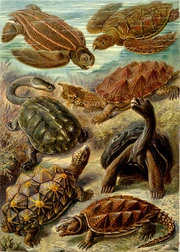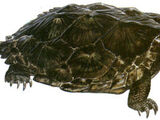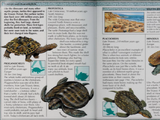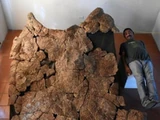(Adding categories) |
(Adding categories) |
||
| Line 15: | Line 15: | ||
[[Category:Cretaceous animals]] |
[[Category:Cretaceous animals]] |
||
[[Category:Triassic]] |
[[Category:Triassic]] |
||
| + | [[Category:Taxonomy]] |
||
Revision as of 00:07, 14 September 2011

Chelonia, an anapsid reptiles superorder.
An anapsid is an amniote whose skull does not have openings near the temples. While "anapsid reptiles" or "anapsida" are traditionally spoken of as if they were a monophyletic group, it has been suggested that several groups of reptiles that had anapsid skulls may be only distantly related. Scientists still debate the exact relationship between the basal (original) reptiles which first appeared in the late Carboniferous, the various Permian reptiles which had anapsid skulls, and the Testudines (turtles, tortoises, and terrapins). Many modern paleontologists believe the Testudines are descended from diapsid reptiles which lost their temporal fenestrae, although that view is not generally accepted (see Parareptilia for details and references). The earliest fossil testudines are from the Triassic, but they were already too like modern turtles to be near the start of their lineage - in particular they already had limb joints within the rib cage. The main article about Testudines covers the debate about their ancestry. Most of the other reptiles with anapsid skulls, including the millerettids, nyctiphrurets, and pareiasaurs, became extinct in the late Permian period by the Permian-Triassic extinction event. But the procolophonids managed to survive into the Triassic.
All items (61)

































































